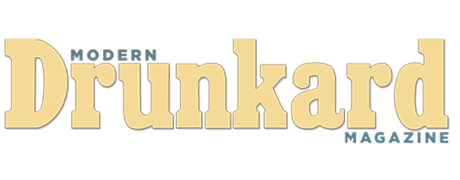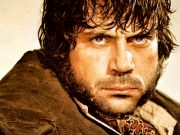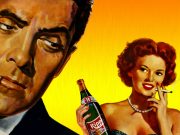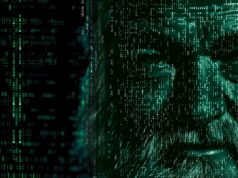“The whole world is three drinks behind,” Humphrey Bogart proclaimed in 1950. “If everyone in the world would take three drinks, we would have no trouble. If Stalin, Truman and everybody else in the world had three drinks right now, we’d all loosen up and we wouldn’t need the United Nations.”
He’d have been more honest if he’d said the world was about twelve drinks behind.
Bogart probably learned to drink from his upper-class but hard drinking parents. He carried the habit through a number of upscale academies and prep schools, managing to get routinely expelled for poor marks and a strong anti-authoritarian streak. Cast adrift at eighteen years of age, Bogart joined the Navy in 1918, hoping to see action in the Atlantic and a different kind of action in Paris. He missed the party by a month.
Decommissioned after the Armistice, Bogart found himself with few plans and less ambition. He took on a number of low-tier jobs in New York City, wiling away months as a biscuit factory worker, tugboat inspector and a message runner until he found steady employment as an office boy at William Brady’s Theatrical Office. Falling in with the boss’s playboy son, Bill Brady Jr., Bogart came into his own as a hard drinker the same year they passed Prohibition. Not that this daunted the headstrong young man.
Liquor might have been illegal, but in wasn’t hard to get in Manhattan. Bogart dove headfirst into the Jazz Age lifestyle, always up for late night revels. He and Brady became notorious drinking companions, managing to stretch their nightly tours of illegal speakeasies until dawn. When his meager wages were exhausted, he’d play chess against all comers in arcades for a dollar a match (he was a brilliant player) to fund his outings. When that money dried up, he used his natural charm to establish immutable and long-standing bar tabs. As much as he enjoyed the glamorous speakeasies, he wasn’t above spending time in less chic joints like Tony’s on 52nd Street, especially when he was broke. The owner Tony Soma was infamous for granting credit to people he liked and he like Bogart. He liked him so much he kept his tab open for over 18 months. Bogart eventually paid it.
It was during this time Bogart most likely got his trademark lip scar and slight lisp. Though the movie studios would later say he received the wound from, alternatively, (1) a shard of shrapnel while his ship was being shelled by a Hun submarine (impossible since Bogart didn’t make it to sea until after the Armistice was signed), or (2) a prisoner he was escorting to the brig asked for a smoke then smashed him in the mouth with his handcuffs. According to his New York drinking cronies, he most likely got the wound in a speakeasy brawl. Bogart had the habit of drinking until he passed out at the table, and when somebody roused him he woke up cracking wise, which as often as not led to a fistfight. Bogart never concerned himself with the scar, and his career didn’t seem to suffer, transforming his too-pretty face into something with a hint of danger.
When he wasn’t carousing with friends, he was content to sit alone at the 21 Club, bent earnestly over a notebook, smoking a pipe and drinking scotch, fancying himself a budding playwright. His taste in booze was the same as most teenagers. A true democrat, he careened wildly between scotch, Black Velvets (equal parts Guinness and champagne), bathtub gin martinis, beer and Jack Rose cocktails.
Working for a theatre company, it was only a matter of time before he caught the acting bug. He thought a great deal of the carefree acting lifestyle, which appeared to consist a few hours on stage, then a lot of hours at the Players Club, drinking with attractive actresses with rather loose morals.
His first role was as a Japanese butler carrying a tray of cocktails and his later roles leaned toward variations on what was called a “white-pants Willy”—the handsome but callow young fellow who was a staple of many drawing-room comedies. His early reviews were not especially promising, his acting slighted as “what is usually and mercifully described as inadequate.”
One of his friends would later say her most vivid remembrance of Bogart was of him sitting alone at a table at Tony’s, drinking steadily with a weary determination, his head drooping lower and lower. By the time she left he’d fallen into exhausted sleep with his head sunk in his arms. “Poor Humphrey,” she told her companion, “he’s finally licked.”
And he was. Well, at least until the following evening. Drinking was a priority and he preferred to drink until dawn, sometimes at the expense of his stage performances. Fired from several productions for showing up so hungover he blew his lines, Bogart shrugged it off, by now he was well known on Broadway and not lacking for work.
Bogart soldiered through and the reviews got better. In what some biographers call a career move, Bogart married Helen Menken in 1926. An established Broadway actress, she did help his career. As equally ambitious as he, the two focused more on their careers than their marriage and it mercifully ended in less than a year.
Following the divorce, as if he needed a reason, Bogart cranked up the hooching. His nightly path could be traced straight from the stage to the nearest speakeasy, where he drowned his sorrows with cocktails and chorus girls. He would later say, “I had had enough women by the time I was 27 to know what I was looking for in a wife the next time I married.”
The next time was a year later. He married another established actress named Mary Phillips. An accomplished drinker, she could keep up with him and in her he found a willing comrade in his quest to drink every bottle in Manhattan.
With Mary’s help, Bogart got choicer parts and in 1930, at the age of thirty-one, Bogart was signed by Fox Studios to make films. Certain this was the break he’d been waiting for, he went to Hollywood to be a star. Mary stayed in New York.
Hollywood was not the fair mistress he thought she would be. Eager to please, Bogart cut down on his carousing and toed the line. He played bit parts in forgettable movies for eighteen months, then beat it back to Broadway in time to watch his father die.
Melancholy after the funeral, Bogart turned to the bottle with such vigor some of his friends suspected him suicidal. He continued to build on his already magnificent tabs at a half-dozen nightclubs, always able to stave off payment with promises that the next big break was right around the corner. Ironically, it was because of his heavy boozing he would get the role that would resurrect his life and career.
 Asked to try out for the role of a cynical gangster at the end of his rope in the play The Petrified Forest, Bogart showed up for the audition with a world-class hangover. Unshaven, bedraggled, puffy-eyed and completely apathetic about getting the part, he came off as exactly what the director envisioned the character should be. The play was an overnight sensation, earning Bogart so many rave reviews that Jack Warner, the president of Warner Brothers Studios, took a train from Hollywood to attend a performance. Bogart was immediately signed to a one-year contract.
Asked to try out for the role of a cynical gangster at the end of his rope in the play The Petrified Forest, Bogart showed up for the audition with a world-class hangover. Unshaven, bedraggled, puffy-eyed and completely apathetic about getting the part, he came off as exactly what the director envisioned the character should be. The play was an overnight sensation, earning Bogart so many rave reviews that Jack Warner, the president of Warner Brothers Studios, took a train from Hollywood to attend a performance. Bogart was immediately signed to a one-year contract.
Now thirty-six years old, Bogart meant to make the most of the opportunity. He relocated to Hollywood to reprise his role in the film version of the play and again his wife remained behind to focus on her Broadway career. Never effusive with his emotions, Bogart kept his own counsel, hooking up with some of the old New York drinking gang who’d also made the leap. He moved into the infamous Garden of Allah, a rambling hotel and bungalow colony off Sunset Boulevard. It was a wild place, housing some of the finest drinkers in the world, and to keep them happy the on-site bar stayed open twenty-four hours a day.
While on the set Bogart was the consummate professional, obsessively punctual and always ready with his lines (he possessed a near-photographic memory). He limited his drinking on the job to a single can of beer he packed in his lunchbox. A cog in the movie factory that was Warner Brothers, he cranked out a movie every six months, usually playing a subsidiary role as a brooding gangster.
When he got off work it was a different story. He would walk into his dressing room, shout, “Scotch!” and his well-trained hairdresser would make drinks for Bogart and whatever guests he brought with him. On the way home he’d stop at Chasen’s or the Brown Derby for drinks with pals, who tended to be writers more often than actors. When he got home he would relax with a few more, then call around to see who was up for some carousing. After organizing his drunkard army, he would march resolutely out to seize the night.
When he wasn’t working on a movie, he started drinking at noon, usually at his favorite haunt, Romanoff’s. He’d enjoy a scotch while waiting for his lunch, two glasses of beer with the food, and a Drambuie as an digestif. Then he’d shift to the Brown Derby where he’d plan the evening’s activities.
“Bogie had an alcoholic thermostat,” screenwriter and drinking comrade Nunnally Johnson said. “He just set his thermostat at noon, pumped in some scotch, and stayed at a nice even glow all day, redosing as necessary.”
When his wife Mary finally came out to see him, Bogart was already involved with his next wife, actress Mayo Methot. If Mary was a giant among drinkers, then Mayo was Godzilla. With a temper to match.
After a speedy divorce, Bogart married Mayo in 1938. The wedding was held at a friend’s estate and quickly set the tone for the rest of their relationship. The celebrity-studded affair, fueled by Black Velvets, quickly denigrated into a drunken orgy, culminating with an explosive battle between the betrothed. Mayo fled in tears to a girlfriend’s house, Bogart took off with his best man and several of the groomsmen to Tijuana.
This was the first act in a long-running production that 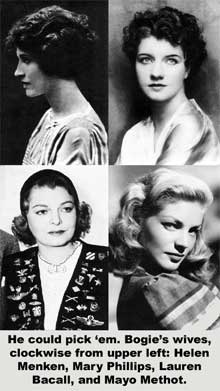 was to become know throughout the world as “The Battling Bogarts”. Whereas Bogart was generally a supremely controlled boozer, Mayo was the classic caricature of the bad drunk. Hollywood soon became acquainted, scandalized, then amused by their booze-fueled public battles, usually involving thrown plates and glassware. It got so bad many clubs issued standing orders against the pair being on the premises at the same time.
was to become know throughout the world as “The Battling Bogarts”. Whereas Bogart was generally a supremely controlled boozer, Mayo was the classic caricature of the bad drunk. Hollywood soon became acquainted, scandalized, then amused by their booze-fueled public battles, usually involving thrown plates and glassware. It got so bad many clubs issued standing orders against the pair being on the premises at the same time.
Perhaps on some level, Bogart needed Mayo. He loved to argue and drink and she was a master at both, if much more given to physical violence. She also helped his career—when they met she was at her cinematic height and could lend a hand up. And up he went, while she started a sullen spiral downward. One critic claimed their volatile relationship helped “set fire to his acting.” She also set fire to their house. And if he needed a little extra inspiration, Mayo was more than willing to come through with some casual gunplay.
Writer Robert Massey and his wife were having cocktails with Bogart in his living room when gunshots rang out from upstairs. “Forget it,” Bogart told his startled guests as he poured himself another drink. “It’s just Mayo playing with her gun.” On another occasion, after Bogart announced he was going to go away for a few days, Mayo produced her pistol and chased him into the bathroom. After threatening to shoot through the locked door, she instead shot his suitcase full of holes, much to the hilarity of Bogart. He called his publicist (never the police) and by the time he arrived, scared out of his wits, Bogart was relaxing in the bathtub with a cocktail.
She eventually stabbed him in the back. Literally. Bogart came home after a night of bar-hopping and Mayo, convinced he was returning from a whorehouse, lunged at him with a kitchen knife, stabbing him in the lower back. Faint from blood loss, he called his agent Sam Jaffe (never a doctor).
“Sam, we have a problem.”
“What’s the matter?”
“I think you should come over here.”
“Why?”
“Mayo stabbed me.”
“Jesus!”
A studio doctor was summoned then bribed not to tell the police. On the advice of Jaffe, Bogart took out a hundred-thousand-dollar life insurance policy. Mayo was not the beneficiary.
Bogart did seem to find at least some inspiration in the constant warfare, turning in some of his finest performances, playing every stripe of drunkard from the noble existentialist drowning his past in Casablanca, to the brooding and violent screenwriter in In A Lonely Place.
The roles weren’t much of a stretch, and the public started having a hard time separating the real Bogart they read about in the gossip columns from the over-the-top roles he played on the screen. He was transforming into a larger-than-life character that unapologetically shoved his way into the American Psyche until he seemed to almost stand astraddle Hollywood, casting a tall shadow that stretched across the entire country.
A shadow that would sometimes touch his fans when they least expected it. Once, after a long night of drinking, Bogart found himself at dawn staggering through unfamiliar Hollywood streets. Hammered, unshaven and disheveled, he noticed a light burning in one of the windows. He approached, drawn by the smell of frying bacon, and looked inside to see a woman cooking breakfast for her family. He stood there a while, leering drunkenly, until the woman noticed him and let loose a scream.
“My God! It’s Humphrey Bogart!”
“What about him?” her husband asked..
“He’s standing in our front yard.”
“Well, invite him in.”
Bogie sat down with the family, enthralling them with ribald tales of Betty Davis, Errol Flynn and James Cagney. He finished breakfast, called a cab and left the family with a story their friends would never believe.
It was during this period Bogart met a man who would also become a Hollywood titan—and his greatest drinking buddy. Bogart crossed paths with screenwriter/director John Huston on the set of High Sierra. Two like minds recognized each other immediately and from their first martini lunch they became legendary drinking companions. With matching wits and a kindred love of drinking, the two would collaborate again and again, assembling some the finest movies of all time in between prodigal bouts of boozing. Their wives began to suspect the pair made movies merely as an excuse to get together and drink, and they might have been right. During the shooting of The Maltese Falcon, To Have And To Have Not, Treasure of Sierra Madre, Beat The Devil and The African Queen they could be found raising hell in Hollywood night clubs, Florida beach bars, Mexican cantinas, Italian cafes and African tents.
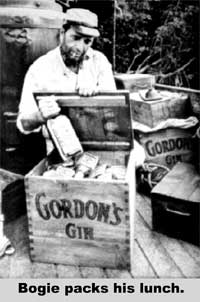 America’s entrance into World War II didn’t appear to have any negative effects on Bogart’s drinking. He demanded to be sent to North Africa and Italy to entertain the troops and Mayo went with him. They took their public brawl on the road and never missed a beat. Good liquor wasn’t always available but they made due. “All we get is plenty of lousy cognac that tastes like fried oil,” Mayo wrote to her mother. “But we drink it.”
America’s entrance into World War II didn’t appear to have any negative effects on Bogart’s drinking. He demanded to be sent to North Africa and Italy to entertain the troops and Mayo went with him. They took their public brawl on the road and never missed a beat. Good liquor wasn’t always available but they made due. “All we get is plenty of lousy cognac that tastes like fried oil,” Mayo wrote to her mother. “But we drink it.”
Bogart enjoyed pounding booze with the enlisted men, if not the officers, and the grateful troops would often give him guns. He and Mayo would return to their USO quarters fantastically drunk and, in the patriotic spirit of the times, would shoot holes in the roof until the guns were wrestled away by startled officers.
As always, Bogart had run-ins with authority. On one occasion, after getting locked out of his room after a drunken battle with Mayo, a colonel confronted him and tried to dress him down (Bogie was wearing a USO uniform). Asking for his name, rank and serial number, Bogart replied. “I’ve got no name. I’ve got no rank. I’ve got no serial number. And you can go to hell.”
Later, when Bogart was reprimanded for insulting the uniform of the United States Army, he apologized to the colonel by stating, “ I didn’t meant to insult the uniform. I meant to insult you.”
He would wind up in hot water again when a party he was throwing for some enlisted men got out of hand. When a general from across the hall told him to quiet it down, Bogart yelled back, “Go fuck yourself!” Soon after Bogart was asked to return to Hollywood.
Bogart made a detour on the way home. Instead of reporting to Hollywood to start filming a new movie, he went AWOL in New York, ditching Mayo and shacking up with ex-wife Helen Menken who accompanied him on a week-long bender. When he finally did return to the set, he brusquely explained he’d lost his calendar.
Bogart loathed idle talk or anything smacking of phoniness. Walk in with a pretension in your heart or a lift to your snoot and he would expertly deflate you. The man loved to needle. To test your cool. He drank with fast company, and some of the fastest minds of the business. The riposte over drinks was as fleet and furious as a firefight, and newcomers entered into the tempest of wisecracks at their own peril. Many a star was reduced to tears or driven to white-faced rage when they tried to mix in. Some, like actor William Holden and director Billy Wilde, didn’t care for the rough treatment and became lifelong enemies. Those that possessed the intellectual skills and courage to defend themselves and counter-attack—sometimes physically—would be quietly admitted into Bogart’s exclusive circle. They knew they made it when, often teetering on the brink of fisticuffs, Bogart smiled at them and said, “Kid, you’re all right.”
Some thought him unreasonably cruel, but Bogart ascribed to a form of conversational Darwinism. If you couldn’t survive the pressure, you could beat it back to your tea party. He didn’t care much for teetotalers either. “I don’t trust a bastard who doesn’t drink,” he was fond of saying. “They’re afraid of revealing their true selves.”
As their marriage shambled on, the drinking and fighting with Mayo intensified to the point it began to spill over into his work. He began showing up on the set hungover and sometimes still drunk. Not that it mattered much–in the middle of filming of Passage to Marseille, he arrived on the set weaving and cockeyed. The crew and cast stood in horror, thinking they would have to reschedule shooting, but when the director yelled action, Bogart stepped into character and delivered his lines as if he were stone cold sober. Other times he needed a little help. During the shooting of the desert war picture Sahara he’d sometimes come in so hungover he’d refused to leave his dressing room until Mayo showed up with a thermos full of martinis. He slugged them down and, now steady as a rock, would turn in a superlative day of acting.
The hallmark of a good drinker, he liked to say, was “he can get absolutely stiff and the fellow next to him doesn’t know it. You had to handle it, it shouldn’t handle you.” And for the most part it was true. Though he would out-drink everyone around him (Huston, Errol Flynn and Richard Burton would often give him a run for his money), at the end of the evening he usually seemed the most sober.
After another especially heavy night of drinking he showed up on the set in his pajamas and refused to work. Instead he rode around the lot on a bicycle shouting, “Look, no hands, no hands!” Finally Jack Warner himself had to come out and speak to him.
“Bogie, what the hell are you doing?”
“Riding my bicycle.”
“It’s time to go to work.”
“I don’t feel like working.”
“You don’t, huh?”
“That’s right, I don’t.”
“Well,” Warner said, “ there’s a lot of people in there who feel like working and they get paychecks that are less than what you spend on scotch.”
Ever sensitive to the plight of the working man, Bogart sheepishly got off his bike and went to work.
On yet another occasion he was to give a public speech at an Easter Service at the Hollywood Bowl. At four in the morning, when he was supposed to show up, Mayo called the studio to report Bogart was still out drinking. He was tracked down to a friend’s house, “drunk as a skunk, unshaven and smelling badly.” Once at the Bowl, however, he stepped on stage and recited the Lord’s Prayer with such sublime emotion he moved the huge congregation and assembled clergy to tears. When a mob swarmed to congratulate him afterwards, his only comment was, “Where can I puke?”
Aside from a few indiscretions, he rarely caused trouble on the set. The notable exception was during the shooting of Sabrina. Directed by Billy Wilder and co-starring William Holden and Katherine Hepburn, Bogart became increasingly angry as the shooting went on, eventually calling his agent and threatening to walk. His agent finally got down to why his client was so upset—Wilder, Holden and Hepburn were going out for drinks after each day’s shooting and not inviting him. To someone who regarded drinking as a sacred ritual, this was the supreme insult.
It was in 1945, during the shooting of To Have and to Have Not that Bogart met his fourth and final wife, Lauren Bacall. A nice nineteen-year-old Jewish girl, twenty-four years his junior and not an especially talented drinker, she seemed an unlikely choice for Bogart. But after many bitter years of warring with Mayo, he appeared tired of battle and was ready for a little peace. And, for perhaps the first time, he genuinely appeared to be in love.
Bacall was as seductive as Eve, as cool as the serpent. Where Mayo fanned the flames of his carousing, Bacall seemed to have a calming effect. In her he found not only a beautiful and intelligent woman, but also a wife who never complained about his drinking, late-night sessions or hangovers. She would join him in the early hours of clubbing then retire before midnight, leaving Bogart to carry on his very personal war against scotch. When he entertained at home, which was practically every night he didn’t go out, she played hostess, expertly mixing pitchers of martinis and making with the rip-crack repartee.
While he didn’t cut down much on his drinking, he did cut down on his selection of drinks. Long time pal and producer Mark Hellinger told him “he was drinking like a boy” and Bogart figured he was right. He stopped mixing his drinks he tried to stick to scotch.
Bogart and Bacall eventual settled into a beautiful fourteen-room house in Bel Air. In the heart of their home was the ‘butternut room’, a wood-paneled study filled with bookcases, comfortable chairs and, of course, a well-stocked bar. This room would become the geographic and spiritual center of Hollywood’s drinking intelligentsia, attracting the greatest minds and personalities of recent history. On a typical evening you’d find Richard Burton with a glass of scotch and his current wife, Sinatra and Bacall throwing together martinis behind the bar, David Niven and John Huston talking movies in the corner, Noel Coward getting catty with Judy Garland. And in the center of it all, cracking wise, needling the new faces, holding court, was Humphrey Bogart, their spiritual leader.
This group would initially call itself the Freeloaders Club but the name was changed in 1955 after a wild week in Vegas. The Bogarts, Frank Sinatra, Judy Garland, her husband Sid Luft, and David Niven jetted down to catch Noel Coward’s show, kicking off a sleepless bender of drinking and gambling. By the fifth day Lauren Bacall, probably the soberest of the lot, announced, “You look like a goddamned rat pack!”
The name stuck. Officially the Holmby Hill’s Rat Pack, they went so far as to draw up a charter, appoint officers and create a coat of arms consisting of a rat biting a human hand. Undoubtedly the hand that fed it. Their motto? “Never rat on a rat.”
“Rats are very well behaved,” Bogart explained, but they were also “for staying up late and drinking lots of booze.”
Though Bogart did much of drinking at home now, he still found time to terrorize clubs on both coasts. Bogart and Peter Lorre once got so drunk at Chasen’s they made off with the restaurant’s immense safe, which they rolled out the door and abandoned in the middle of Beverly Boulevard.
This was also the time of the notorious Panda incident, Bogart’s first true run in with the law and first time he would go to court, divorces aside. After dropping off Bacall at the hotel at 10 p.m., Bogart and an old Broadway drinking buddy decided to continue the revelry at New York’s chic El Morocco Club. En route they picked up a pair of large stuffed animals, pandas, to serve as their drinking dates. At about 3:45 in the morning a pair of young ladies, a model and a socialite, decided they would make off with the pandas. In the process of thwarting the attempted panda-napping, Bogart may or may not have shoved the women to the floor. A brouhaha ensued, with Bogart trading a volley of plates with the socialite’s boyfriend, an actual gangster.
Bogart was dragged into court the next morning to face charges of assault and battery. Flippant and cool, he suggested the ladies were merely publicity seekers and the pandas had done them no wrong. The case was dismissed. At least in the eyes of the law.
Asked by the press if he was “stiff” during the incidence, Bogart replied, “Who isn’t at 3 o’clock in the morning? So we get stiff once in a while. This is a free country isn’t it? I can take my panda any place I want to. And if I want to buy it a drink, that’s my business.” And besides, he said, “Errol Flynn and I are the only ones left who do any good old hell raising.”
The president of New York’s Society of Restaurateurs responded with dire threats, telling the press that Bogart, Errol Flynn and any other celebrity hell-raisers would get the “bum’s rush” if they dared “get stiff and raise hell” in a New York restaurant, club or bar. Bogart was then promptly banned for life from the El Morocco and a dozen other clubs in town, adding to his rather impressive list in Los Angeles.
“You got to hand it to him,” Bacall would later say. “When he gets barred, he gets barred from all the right places.”
Bogart fired back at the club owners: “Some people think the only thing I’ve done is get involved in barroom bouts. Why, I’ve been in over forty plays. I’ve done some lasting things too. What they are I can’t think of at the moment, but there must have been some.”
It probably seemed a good time to leave the country and Bogart reunited with Huston for another film, The African Queen. A fanatic for realism, Huston built his set deep in the jungles of the Congo, far from civilization. There were few creature comforts, but Huston did have the foresight to build a “saloon tent” in the center of their camp, where you could buy a shot of liquor for a quarter. Playing the role of a gin-swilling riverboat captain, Bogart stayed in character off camera, except he substituted scotch for gin. “The food was awful so we had to drink scotch all the time,” he explained to an interviewer.
His co-star was the rather temperate Katherine Hepburn who tried to seize the moral high ground after the first day of shooting. She stormed into the saloon tent to lecture Bogart and Huston on the evils of drink. When she finished Bogart smiled and said, “You’re absolutely right, Kate. Now pull up a chair and have a drink.” She declined. Hepburn viewed Huston and Bogie as “rascals, scamps and rogues,” and they did all they could to reinforce this belief, staging pretend fistfights and behaving like old Irish drunks.
Ironically (to some), it was evil drink that would be the savior of Huston and Bogart—midway through shooting everyone but the pair came down with dysentery. The camp’s supply of bottled water turned out to be tainted with parasites. Hepburn, who had hoped to shame the drunkards by drinking nothing but water, was the sickest. As Hepburn put it, “those two undisciplined weaklings had so lined their insides with alcohol that no bug could live in the atmosphere.”
“I built a solid wall of scotch between me and the bugs,” Bogart agreed. “If a mosquito bit me, he’d fall over dead drunk.”
Hepburn was forced to take to champagne. “It really was a very good joke on me,” she said. “Especially as privately I had felt so completely superior to that unhealthy pair.”
The African Queen also had the distinction of being the first movie to utilize product placement—Gordon’s Dry Gin, fittingly enough. You’ll find Bogart’s character not only guzzling it by the bottle, but cases of the stuff thrown overboard by Hepburn’s teetotaling character.
For his performance Bogart would earn his first and only Oscar. After the award ceremonies he celebrated with an impromptu game of football on his lawn with Huston, a screenwriter and a studio exec. Still wearing their tuxedos, caked with mud, smashed quite out of their minds, they used a grapefruit in lieu of a football. This was a man over fifty years of age.
Like a scarred veteran returning from decades of war, Bogart took on the calm demeanor of a man confident with his cups and more than willing to say so. Though Bogart was always a very self-contained man, possessed of a tightly wrapped aloofness even Bacall failed to penetrate, he was very open about his love of drink. “Scotch,” he would say, “is a very valuable part of my life.” When asked if he had ever went on the wagon he replied, “Just once. It was the most miserable afternoon of my life.” By all reports, he wasn’t exaggerating.
Unlike today’s celebrities, who wouldn’t admit to being a drunkard if you held a gun to their collective heads, Bogart reveled in the title, never bending an ear to critics of his public behavior. “People who live in glass houses need ear plugs and a sense of humor,” he said. “When I chose to be an actor I knew I’d be working in the spotlight. I also knew that the higher a monkey climbs the more you can see of his tail. So I keep my sense of humor and go right on leading my life and enjoying it. I wouldn’t trade places with anybody.”
Latter-day biographers and armchair psychologists all had a crack at why he liked to drink so much. They blamed inner insecurities, the stress of the celebrity life, his dysfunctional childhood, and so forth. What none of them seem to understand is that some people simply like to drink. That it adds a missing quality to life, makes grey days shine like gold, makes tedious situations seem interesting.
George Bernard Shaw summed it up best when he said, “No man who is occupied in doing a very difficult thing, and doing it very well, ever loses his self respect. The common man may have to found his self-respect on sobriety, honesty and industry; but an artist needs no such props for his sense of dignity.” In other words, having accomplished his goal of becoming the world’s paramount actor, Bogart didn’t give a damn what the world thought of his personal habits.
Time magazine called him “one of a handful of old-timers whose acting reputation and box office value is indestructible, and whose Hemingwayish philosophy tends to make him morally indestructible in that nothing he does or says will surprise or scandalize anyone—an enviable spot these days when high-earners in Hollywood are afraid to spit on the sidewalk lest they cut industry grosses by a third.”.
Not surprisingly, Bogart’s legend has overshadowed all of his image-conscious contemporaries. For good reason. As actor Rod Steiger pointed out, “Bogart has endured because in our society the family unit has gone to pieces. And here you had a guy about whom there was no doubt. There is no doubt that he is the leader. There is no doubt that he is the strong one. There is no doubt with this man that he can handle himself, that he can protect the family. This is all unconscious, but with Bogart you are secure, you never doubt that he will take care of things.”
Bogart was diagnosed with cancer of the esophagus in January of 1956. He underwent nine hours of surgery then convalesced for months. True to his code, he never spoke of the disease that made his body waste away, and he never stopped drinking. As soon as he got back from the hospital he climbed off the wagon, although he did switch from scotch to martinis. He and Bacall still held sessions in the butternut room and famous drinkers the world over came by for a drink and pay homage to their dying king.
The cancer returned and Humphrey Bogart died January 4, 1957 at the age of fifty seven, with nothing left to prove. His last words were about drinking: “I never should have switched from scotch to martinis.”
Delivering Bogart’s eulogy, John Huston declared: “Bogie’s hospitality went far beyond food and drink. He fed a guest’s spirit as was well as his body, plied him with good will until he became drunk in the heart as well as his legs.”

